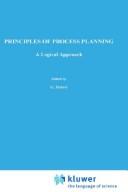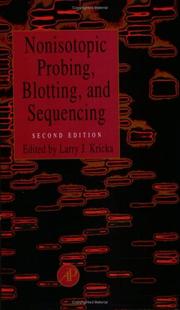| Listing 1 - 3 of 3 |
Sort by
|

ISBN: 0412543605 Year: 1995 Publisher: London Chapman and Hall
Abstract | Keywords | Export | Availability | Bookmark
 Loading...
Loading...Choose an application
- Reference Manager
- EndNote
- RefWorks (Direct export to RefWorks)
Process planning determines how a product is to be manufactured and is therefore a key element in the manufacturing process. It plays a major part in determining the cost of components and affects all factory activities, company competitiveness, production planning, production efficiency and product quality. It is a crucial link between design and manufacturing. There are several levels of process planning activities. Early in product engineering and development, process planning is responsible for determining the general method of production. The selected general method of production affects the design constraints. In the last stages of design, the designer has to consider ease of manufacturing in order for it to be economic. The part design data is transferred from engineering to manufacturing and process planners develop the detailed work package for manufacturing a part. Dimensions and tolerances are determined for each stage of processing of the workpiece. Process planning determines the sequence of operations and utilization of machine tools. Cutting tools, fixtures, gauges and other accessory tooling are also specified. Feeds, speeds and other parameters of the metal cutting and forming processes are determined.
Production planning --- capp --- dimensioneren --- machinebouw --- positionering --- processen --- productie --- snijden --- spc --- toleranties --- 658.512 --- Manufacturing planning --- Process planning --- Planning --- Production engineering --- 658.512 Production plan, schedule. Determination of sequence of operations (sequencing). Routeing --- Production plan, schedule. Determination of sequence of operations (sequencing). Routeing --- Production management --- SPC (statistical process control) --- CAPP (computer aided program production) --- productontwikkeling --- productieprocessen
Periodical
Abstract | Keywords | Export | Availability | Bookmark
 Loading...
Loading...Choose an application
- Reference Manager
- EndNote
- RefWorks (Direct export to RefWorks)
General microbiology --- Molecular biology --- Nanotechnology --- Molecular evolution --- Biologie moléculaire --- Nanotechnologie --- Evolution moléculaire --- Periodicals. --- Périodiques --- Évolution moléculaire --- Molecular biology. --- Molecular evolution. --- Nanotechnology. --- Evolution, Molecular. --- Molecular Biology. --- Molecular Sequence Data. --- Molecular Sequencing Data --- Sequence Data, Molecular --- Data, Molecular Sequence --- Data, Molecular Sequencing --- Sequencing Data, Molecular --- Biochemical Genetics --- Biology, Molecular --- Genetics, Biochemical --- Genetics, Molecular --- Molecular Genetics --- Biochemical Genetic --- Genetic, Biochemical --- Genetic, Molecular --- Molecular Genetic --- Genetic Evolution --- Molecular Evolution --- Evolution, Genetic --- Directed Molecular Evolution --- Periodicals --- Chemistry --- Information Technology --- Life Sciences --- General and Others --- Automation --- Robotics --- Biochemistry --- Biology --- Evolutionary Studies --- Genetic Phenomena --- moleculaire biologie --- Evolution, Molecular --- Molecular Biology --- Molecular Sequence Data

ISBN: 1281037249 9786611037246 0124262929 0080537669 0124262910 Year: 1995 Publisher: Burlington Academic Press
Abstract | Keywords | Export | Availability | Bookmark
 Loading...
Loading...Choose an application
- Reference Manager
- EndNote
- RefWorks (Direct export to RefWorks)
Since the publication of Nonistopic DNA Probe Techniques in 1992, the move away from radioactive materials for research and diagnostics has continued. This is due in part to public awareness of the hazards of radioactive waste and laws making radioactive disposal more difficult and costly and to improvement in both the sensitivity and convenience of nonisotopic techniques. Several new nonisotopic techniques have been developed and substantial improvements made to existing nonisotopic methods since 1992, and these are now included in Nonisotopic Probing, Blotting, and Sequencing.<
Amino acid sequence. --- Bioluminescence assay. --- Chemiluminescence assay. --- Immunoblotting. --- Molecular probes. --- Nucleotide sequence. --- Analysis, Nucleic acid sequence --- Analysis, Nucleotide sequence --- Base sequence (Nucleic acids) --- DNA sequence --- Nucleic acid sequence analysis --- Nucleotide sequence analysis --- RNA sequence --- Sequence, Nucleotide --- Nucleic acids --- Nucleotides --- Sequence alignment (Bioinformatics) --- Bioprobes --- Probes, Molecular --- Molecular biology --- Affinity labeling --- Dot immunoblotting --- Electroimmunoblotting --- Immunoelectroblotting --- Reverse immunoblotting --- Antigens --- Immunoassay --- Chemiluminescent assay --- Biological assay --- ATP luminescence assay --- Bioluminescent assay --- Amino acid sequence analysis --- Analysis, Amino acid sequence --- Peptide sequence --- Peptide sequencing --- Protein sequence --- Protein sequencing --- Sequence, Amino acid --- Amino acids --- Proteins --- Analysis --- Technique
| Listing 1 - 3 of 3 |
Sort by
|

 Search
Search Feedback
Feedback About
About Help
Help News
News